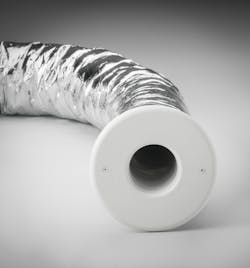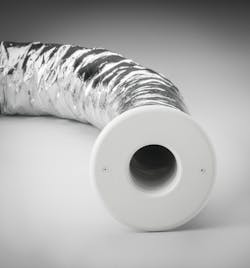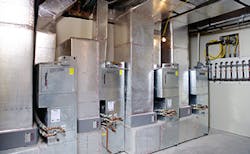Exceptional Performance of Small Duct High Velocity Distribution Systems
In the 1940’s, a new kind of HVAC system was introduced to the market. Today, it’s called a Small Duct High Velocity System (SDHV). Although it’s a relatively small segment of our industry, the SDHV system’s exceptional performance and operating efficiency deserves our attention. Let’s take a look at SDHV systems and what we can learn from how well they perform in the field.
What is SDHV?
SD stands for Small Duct. Small means 2-in. diameter branch ducts. HV means High Velocity. This means discharge air velocity averages 1200-1300 feet per minute (fpm). Other defining characteristics include required airflow of 250 cfm per nominal ton of cooling. Equipment discharge ducts are also smaller to maintain equal pressures and velocities throughout the system.
In SDHV systems supply registers are replaced with nozzles that have no louvers restricting airflow at the outlet. High-velocity nozzles heat and cool rooms by discharging high velocity jets of air. The jet effect mixes heated or cooled air with room air. Jets are placed to avoid drafts by creating air mixing zones where high air velocity is not detected by room occupants.
Some SDHV History
In 1946, a jet engine pioneer named Calvin McCracken built a heating system called “Jet Heet” in New Jersey. This first small duct system consists of high velocity insulated ducts. Life Magazine labels it a “giant octopus that squeezes heat into a room.”
It wasn’t until the mid-1970’s when two manufacturers began commercially developing high-velocity air handlers and duct materials for the HVAC contracting industry. Gradually, these systems increased in popularity. Today they continue to improve and expand more into the marketplace.
New laws governing HVAC efficiency began around 2001 as the U.S. Department of Energy (DOE) established the 13-SEER minimum requirement for cooling equipment. Soon thereafter DOE created a new equipment classification for what they titled SDHV.
Looking to the future, several studies indicate SDHV may be one of the best solutions to effectively condition low-load homes. It solves the heating, cooling, and ventilation issues of homes that only require one ton of cooling for every 1000 to 2000 square feet.
Today, high-velocity systems play an increasing role in the residential and light commercial market as consumers demand more solutions to satisfy their specific needs. These systems are used in homes, historical buildings, offices, and industrial applications requiring spot cooling.
Looking to the future, several studies indicate SDHV may be one of the best solutions to effectively condition low-load homes. It solves the heating, cooling, and ventilation issues of homes that only require one ton of cooling for every 1000 to 2000 square feet.
Here are some factors that account for the remarkable performance of small, high-velocity duct systems:
Low Duct Leakage
Low duct leakage is one key benefit of SDHV systems. Field testing confirms air duct losses are up to 90 percent less than in conventional air distribution systems under typical installation conditions.
This fact is surprising considering operating pressures are double that of conventional systems. In conventional systems when you double the duct system pressure, it more than doubles the air leakage. In SDHV systems, air loss is low because duct construction is small and mechanical connections to other distribution system components are extremely tight.
Low Duct Thermal Loss
Temperature loss through duct systems is easily measured by taking equipment discharge air temperature, then measuring air temperature at the farthest outlet. Ideally, the two temperatures should be the same. Subtract the two temperatures to identify the amount of duct temperature loss or gain through the supply duct system.
Conventional cooling or heating duct systems under extreme temperature conditions (such as in a hot attic), lose a significant amount of temperature through the duct. This is during summer months when full cooling system capacity is needed the most. This time of year, a 7F or 8F degree duct gain is not uncommon. Considering the temperature change over the equipment may be 20F, a 7F duct gain reduces system efficiency by 35 percent (7F divided by 20F = 35 percent).
Under these conditions, think about how ducting can act like a furnace in a 130F attic. With 55F air in the duct and 130F air in the attic, the 75F temperature difference draws the attic heat into the cooler duct.
The greater the duct surface area the more heat transfer occurs. A conventional system often has 400 sq.ft. of duct surface area. Because of smaller duct diameter and shorter duct length, a typical SDHV system may have a duct surface area less than 100 sq.ft. That’s a 75 percent reduction and that substantially decreases heat transfer, while increasing duct efficiency.
Another factor is the amount of dwell time air spends in the duct system. In a hot attic, this is affectionally called air bake time by techs who measure duct temperature changes.
Conventional system duct velocity is near 400-500 fpm. SDHV duct velocity is up to three times faster and reduces the bake time in the duct.
More SDHV Benefits
Additional benefits of small duct systems include, increased ventilation and dehumidification, better room air mixing, increased room comfort, and lower operating noise.
Increased Dehumidification is a result of colder coils and less cfm-per-ton of cooling. In addition to improved room ventilation, fan-on only power consumption was shown to be much lower using the SDHV variable-speed blower. Both result in improved comfort levels.
Efficient Air Mixing - In 2019, the Air Conditioning Contractors of America (ACCA) published a design manual for low-load homes titled, Manual LLH (Low Load Homes). SDHV systems are considered among the best solutions for low-load buildings. One reason is that the basic principles influencing room comfort are addressed with high-velocity systems.
HVAC systems mix conditioned air with room air. A conventional system air-mixing zone having an air velocity of 300 to 500 fpm and a throw of 7 to 9 feet may have relatively poor air-mixing patterns. The jet-like velocity of SDHV air nozzles (1200 fpm or more and a throw of up to 20 feet) provides better coverage, humidity and temperature control, and decreased stratification.
Low Sound Levels - In the past, SDHV noise levels were a concern for consumers. With advancement in nozzle design and decreased operating pressures, high-velocity systems are now recognized for their low noise levels.
Equipment operating noise has been decreased and 3-ft. sound-attenuating acoustical ducts (mufflers) are available from some SDHV manufacturers. High-velocity systems are increasingly specified for sound recording studios and conference rooms.
Looking Forward
SDHV manufacturers remain the only equipment manufacturer to build duct system components unique to their air handlers. Unfortunately, DOE lacks the authority to recognize and reward the significant energy savings offered by SDHV air distribution systems.
Is it time DOE focused on installed system efficiency as well as equipment efficiency? Many have found greater energy savings by installing better ducts than higher efficient equipment.
DOE’s current HVAC efficiency regulations are comparable to rating automobile Miles-Per-Gallon by testing the motor’s performance in a laboratory. Is it time DOE focused on installed system efficiency as well as equipment efficiency? Many have found greater energy savings by installing better ducts than higher efficient equipment.
Rob “Doc” Falke serves the industry as president of National Comfort Institute, Inc., an HVAC-based training company and membership organization. If you're an HVAC contractor or technician interested in a free test procedure and performance report for SDHV systems, contact Doc at [email protected] or call him at 800-633-7058. Go to NCI’s website at nationalcomfortinstitute.com for free information, articles, and downloads.
About the Author
Rob 'Doc' Falke
President
Rob “Doc” Falke serves the industry as president of National Comfort Institute an HVAC-based training company and membership organization. If you're an HVAC contractor or technician interested in a building pressure measurement procedure, contact Doc at [email protected] or call him at 800-633-7058. Go to NCI’s website at NationalComfortInstitute.com for free information, articles and downloads.



